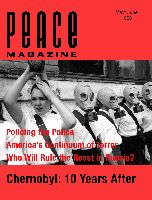
Peace Magazine May-June 1996, page 11. Some rights reserved.
Search for other articles by Norman Abbey here
From Goose to Nanoose, it's decision-time on both coasts for our new Foreign Minister Lloyd Axworthy. At Goose Bay, Labrador (Nitassinan) Low Level Flight Testing is up for a 10-year renewal. And in British Columbia, it's "Countdown Year" at the anti-submarine warfare facility at Nanoose Bay (March/April Peace). Axworthy can scrap this Cold War relic, or extend the agreement for another 10 years.
The NDP government of B.C. and both opposition parties long ago (1992) requested a public environmental review of Nanoose. On February 16 that demand was echoed by local Reform M.P. Bob Ringma, who asked Defence Minister David Collenette to "make any formal discussions on renewal or cancellation of this agreement subject to full public participation and review." This rare consensus uniting both NDP and Reform also includes 51 out of 52 members of the B.C. legislature from the B.C. Liberal and the (then) Social Credit parties, as well as municipal governments and community groups. And that rare political consensus is backed up by science.
Jackson Davis, Professor of Biology in the University of California's Nuclear Policy Program, studied potential nuclear accidents on military vessels in British Columbia. He examined two scenarios: incineration of a nuclear warhead in a shipboard fire, and a nuclear reactor accident. In the former, a radioactive cloud containing plutonium-239 would be carried over populated areas by prevailing winds. "The plutonium concentration in the cloud would exceed U.S. federal (NRC) limits for air contamination by up to ten thousand times. Ground contamination from fallout would exceed the limits by up to one million times. Exposure from plutonium inhalation would exceed the limits for 'routine' releases by up to one hundred thousand times." The other scenario, a four-hour reactor accident aboard a ship, would produce "downwind air concentrations of the radio nuclides as well as ground deposition, exceed[ing] the NRC limits by hundreds to millions of times." Either scenario would lead to both "prompt" and long-term fatalities as well as latent cancers and genetic defects. Although these would be considerable, Davis warns that "the most significant impact could be economic."
U.S. government studies indicate that decontamination of such a hypothetical disaster could cost tens of billions of U.S. dollars and take months to complete, during which time the local economy would be largely paralyzed. The ecological and economic impacts of such an accident on surrounding salt water bodies were not considered, but could also be significant. While Davis analysed a hypothetical scenario, the U.S. government says actual clean-up of radioactive waste from decades of nuclear weapons production will take longer than the Cold War itself, and cost between $230 and $350 billion (this is even if the Davis accident never happens!).
There are other reminders of our nuclear predicament.
The world was horrified by France's recent nuclear binge. President Chirac became a born-again advocate of a Comprehensive Test Ban, proving that a lot can happen in one day. A lot also can happen in 200,000 years. That's how long we'll need to keep the radioactive waste beneath Mururoa's fragile atoll isolated from the biosphere.
Ontario Hydro's prematurely aging nuclear reactors are drowning in red ink and unsolved waste disposal problems, yet "Team Canada" continues to flog the plutonium-producing CANDU technology to such dictators as Li Peng, while Atomic Energy Canada feeds off taxpayers to the tune of $13 billion, according to Campaign for Nuclear Phaseout.
Jory Lord, the B.C. sailor run down by a Chilean submarine invited to Canada by the U.S., was hung out to dry by all three countries. Chile, our "fourth amigo" in NAFTA, continues to exercise its submarines in B.C.
U.S. belligerence (threats to punish Canada for trading with Cuba, and the challenge to Canadian sovereignty in the Georgia Strait, between Vancouver Island and the rest of B.C.) may actually help forge a stronger alliance for an independent Canadian foreign policy, and for the de-militarization of Canadian waters.
But here are a few grounds for optimism:
There is a rare political consensus spanning all parties for public review of nuclear ships' access to Canadian waters.
The Nanoose Conversion Campaign (NCC) and End the Arms Race have just released a video narrated by David Suzuki, and are conducting a massive postcard campaign. As well as researching an independent cost-benefit analysis of Nanoose, these groups are also considering prosecuting the Department of National Defence under federal Fisheries law for dumping over a million kilograms of lead and other metals into salmon habitat in Georgia Strait.

Peace Magazine May-June 1996, page 11. Some rights reserved.
Search for other articles by Norman Abbey here